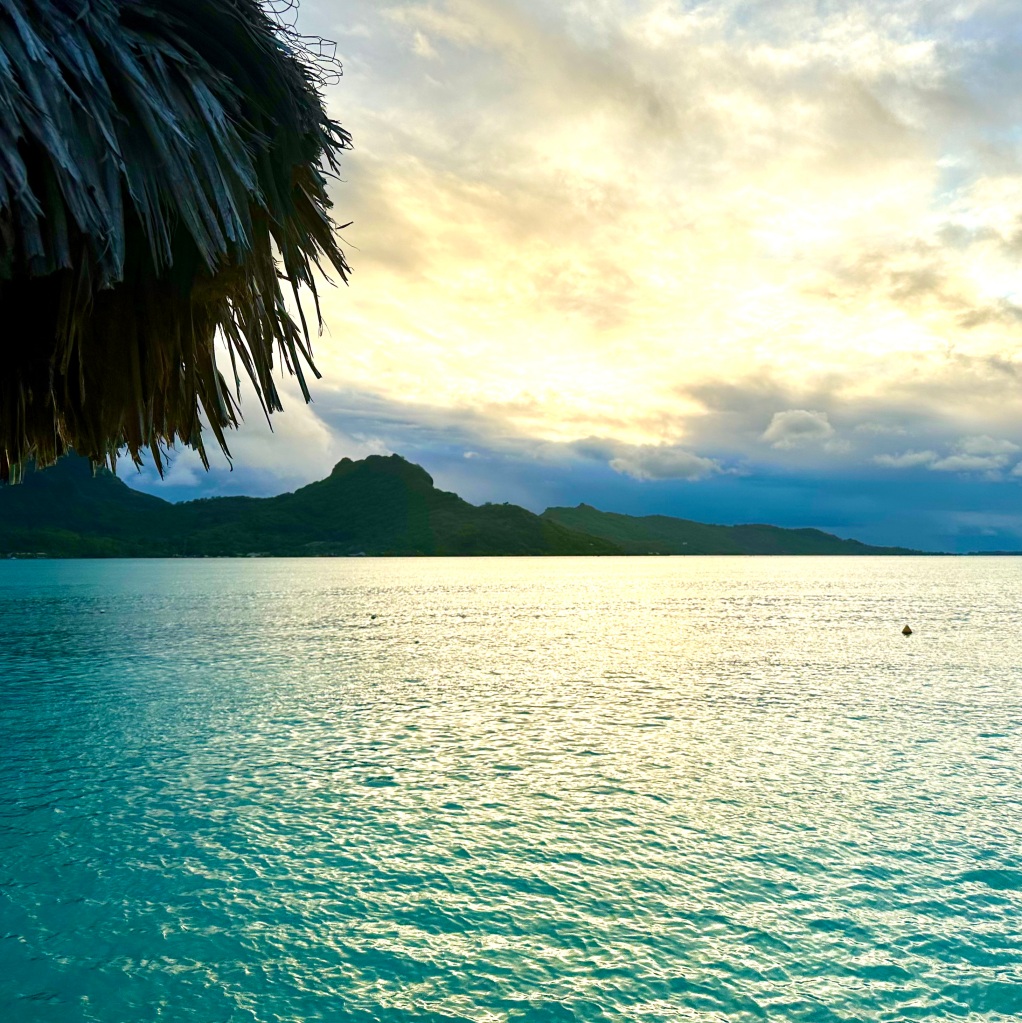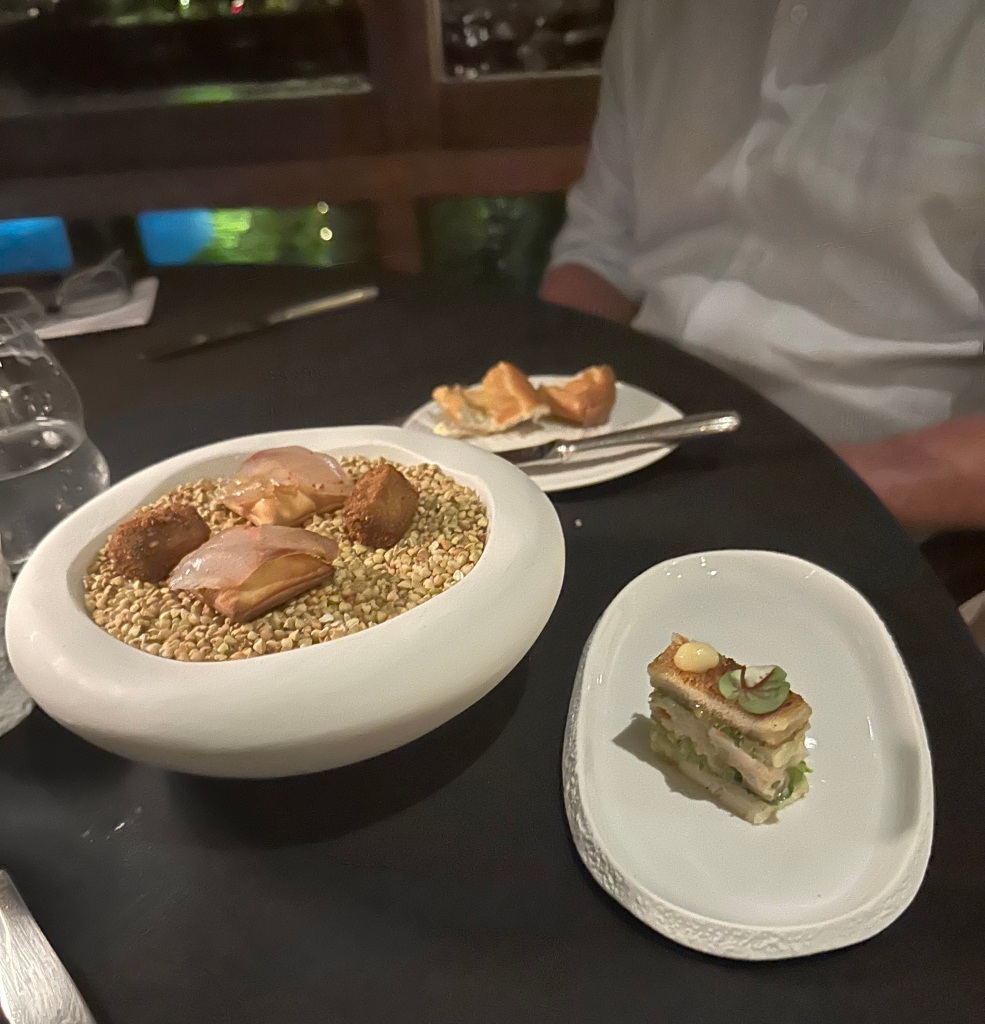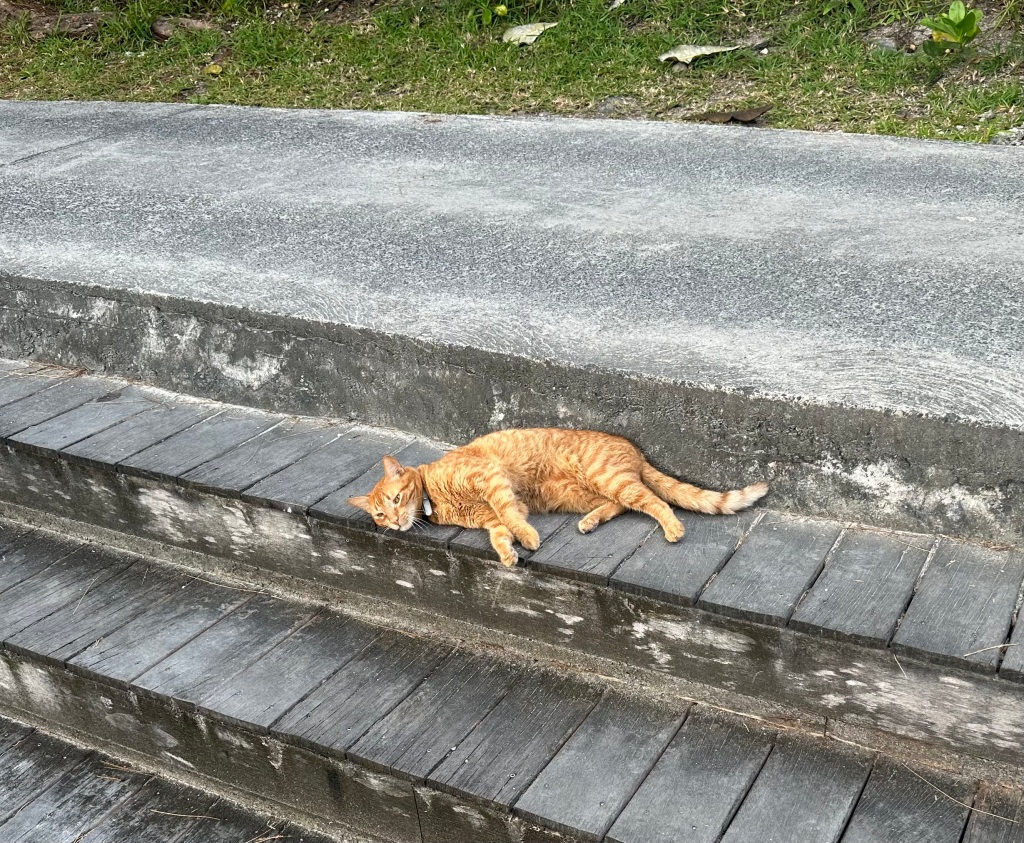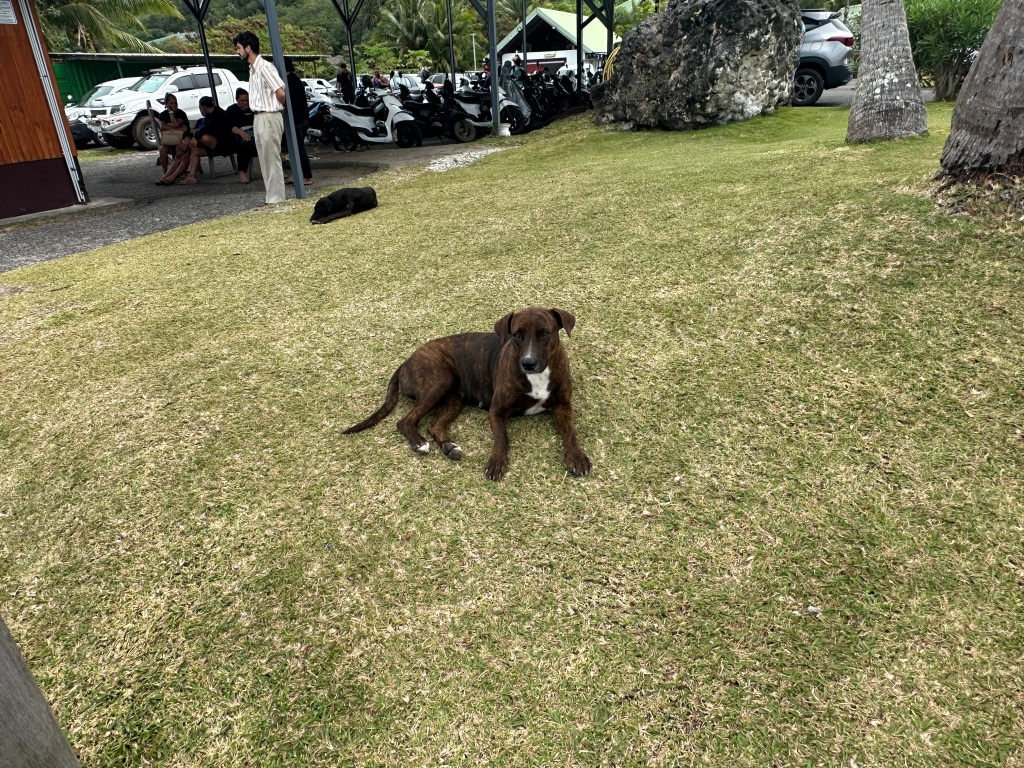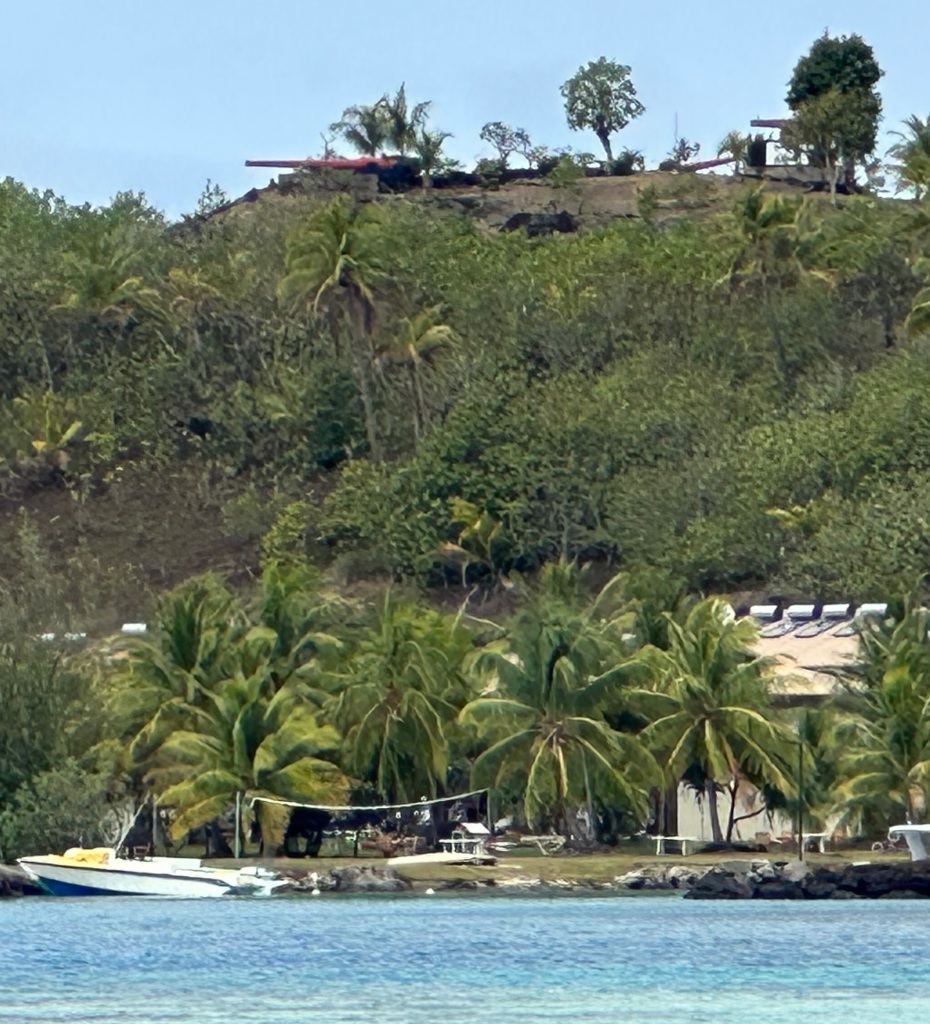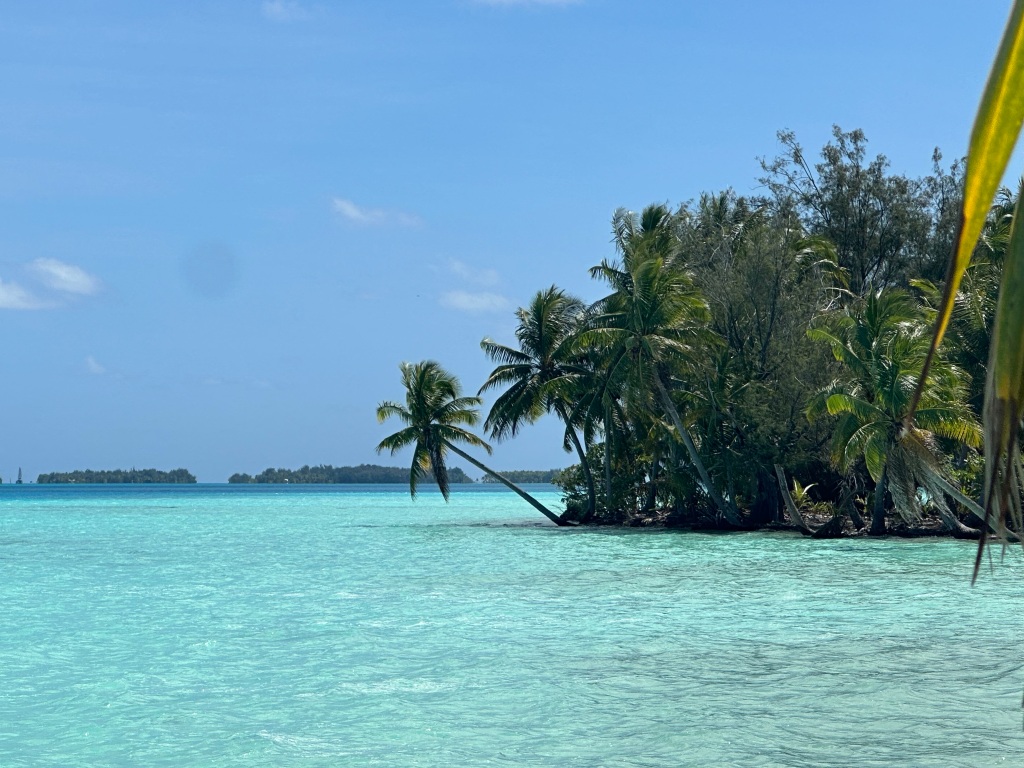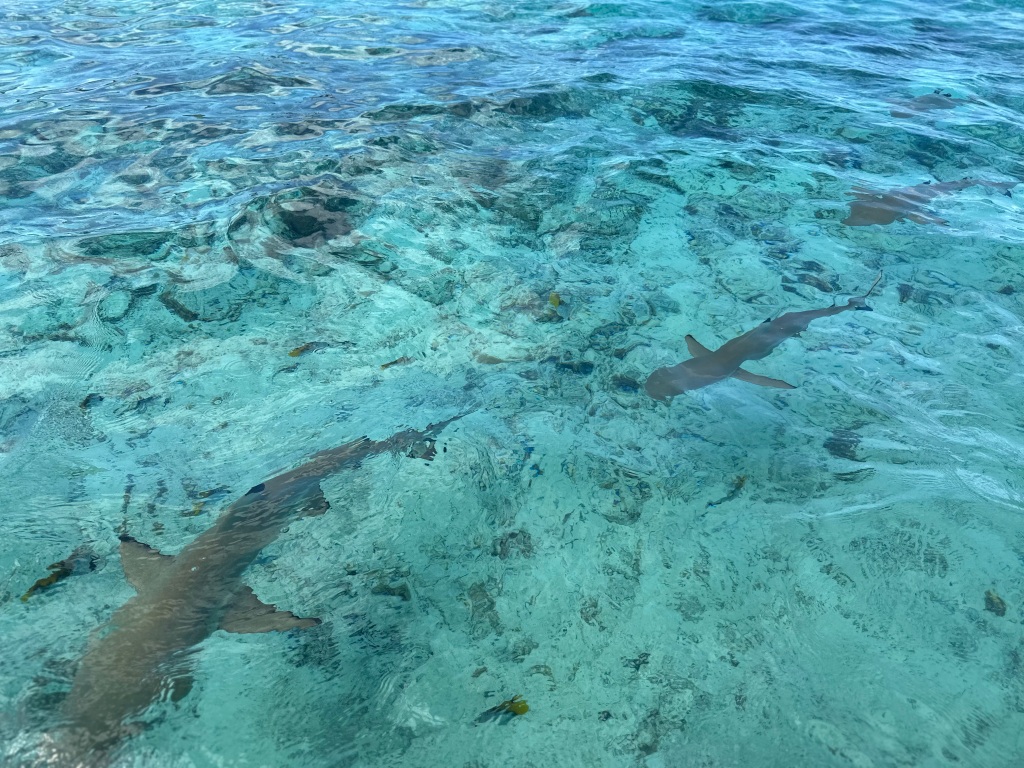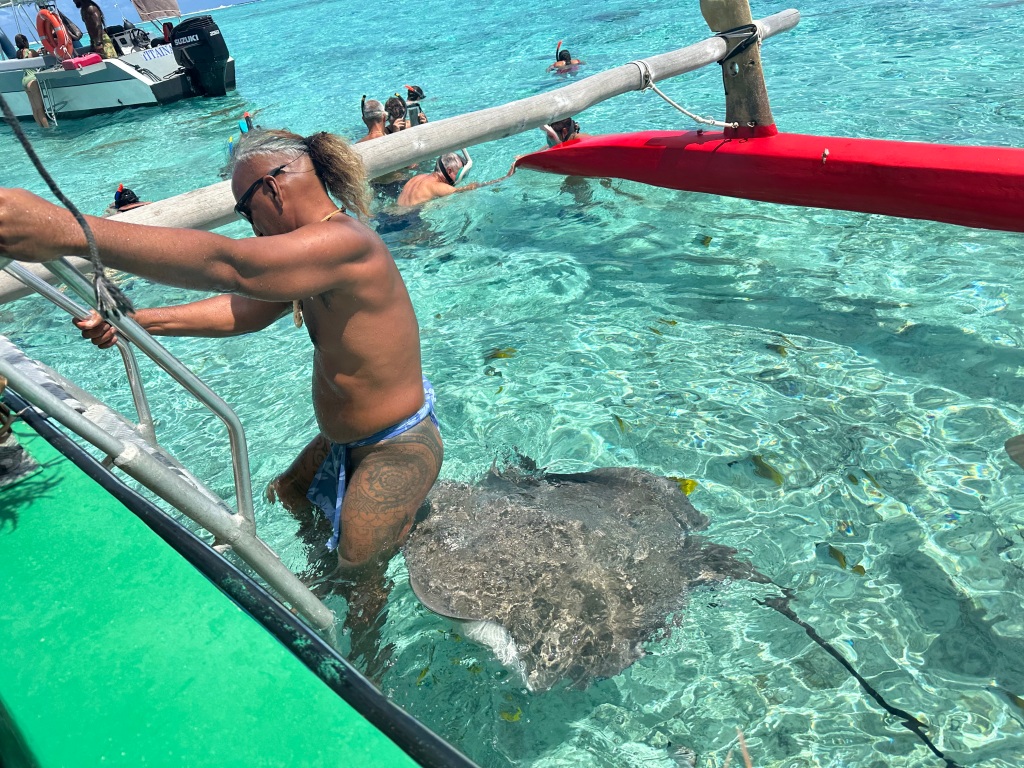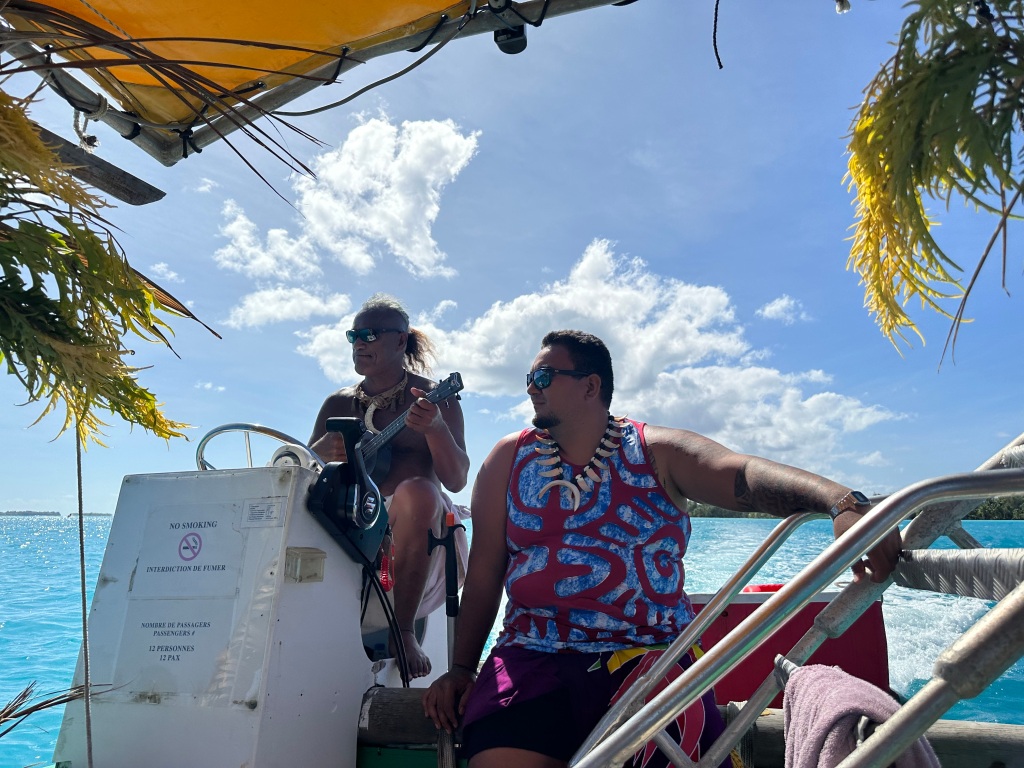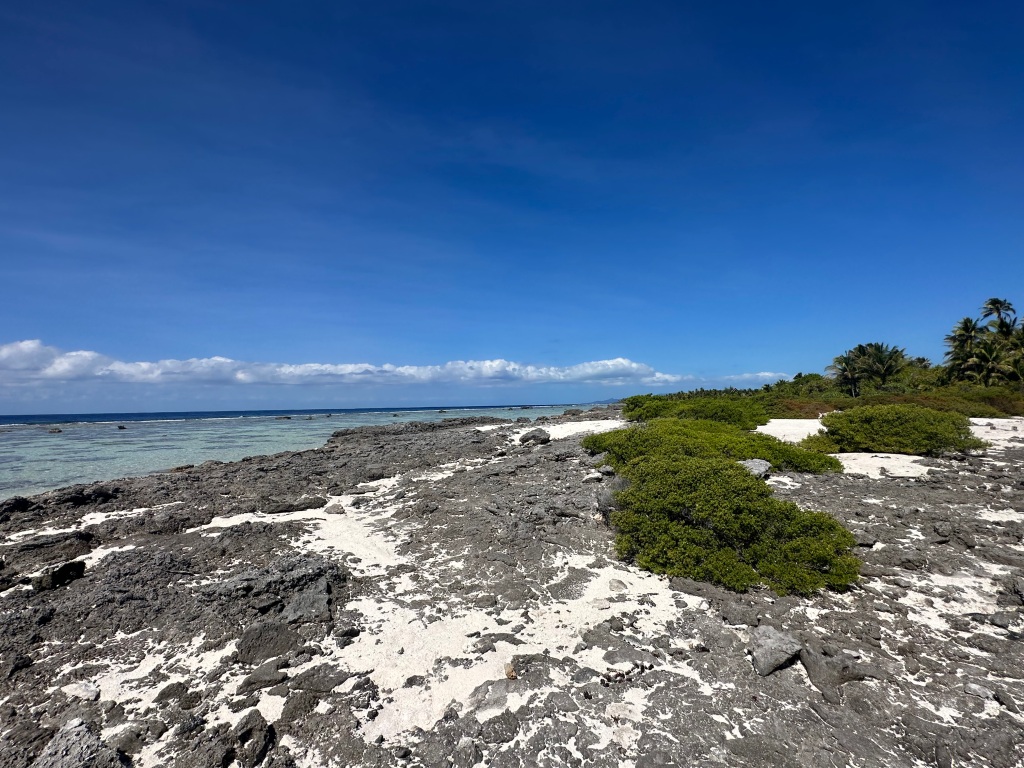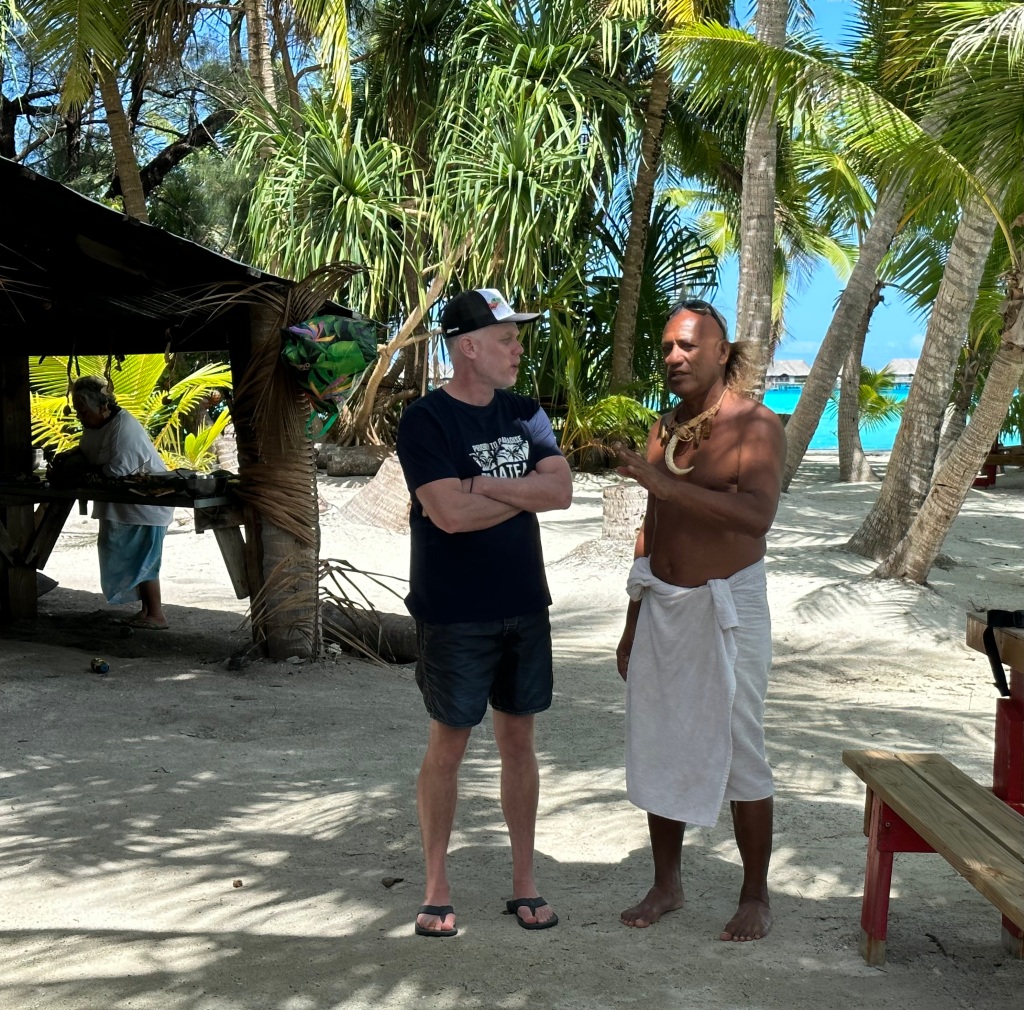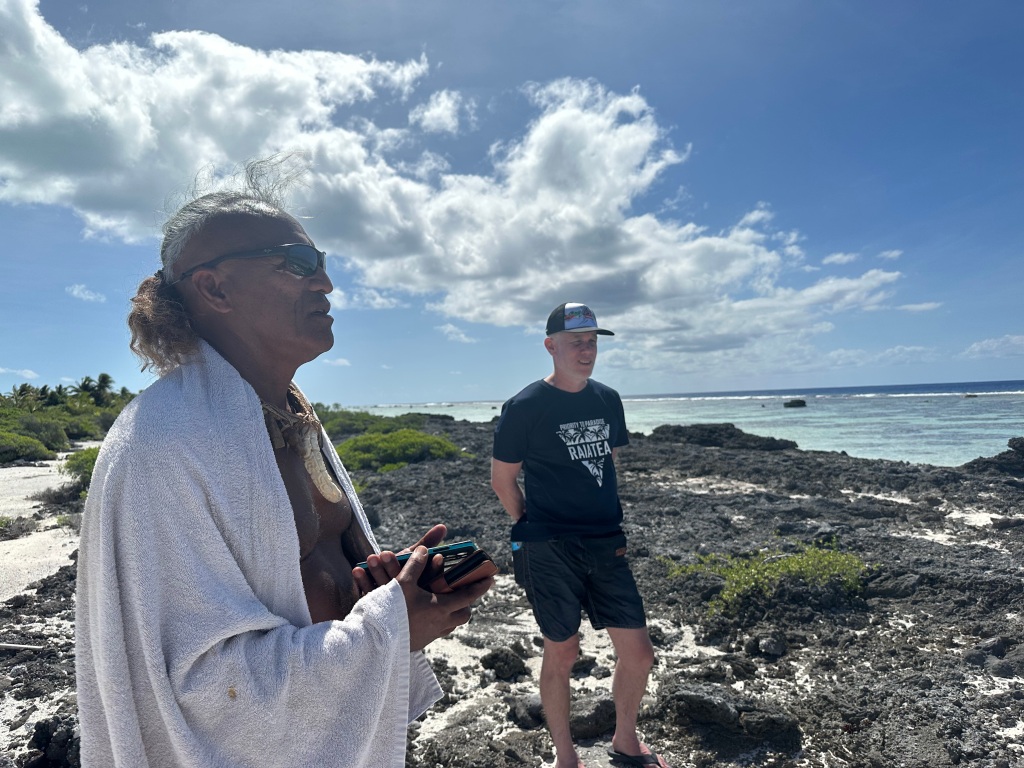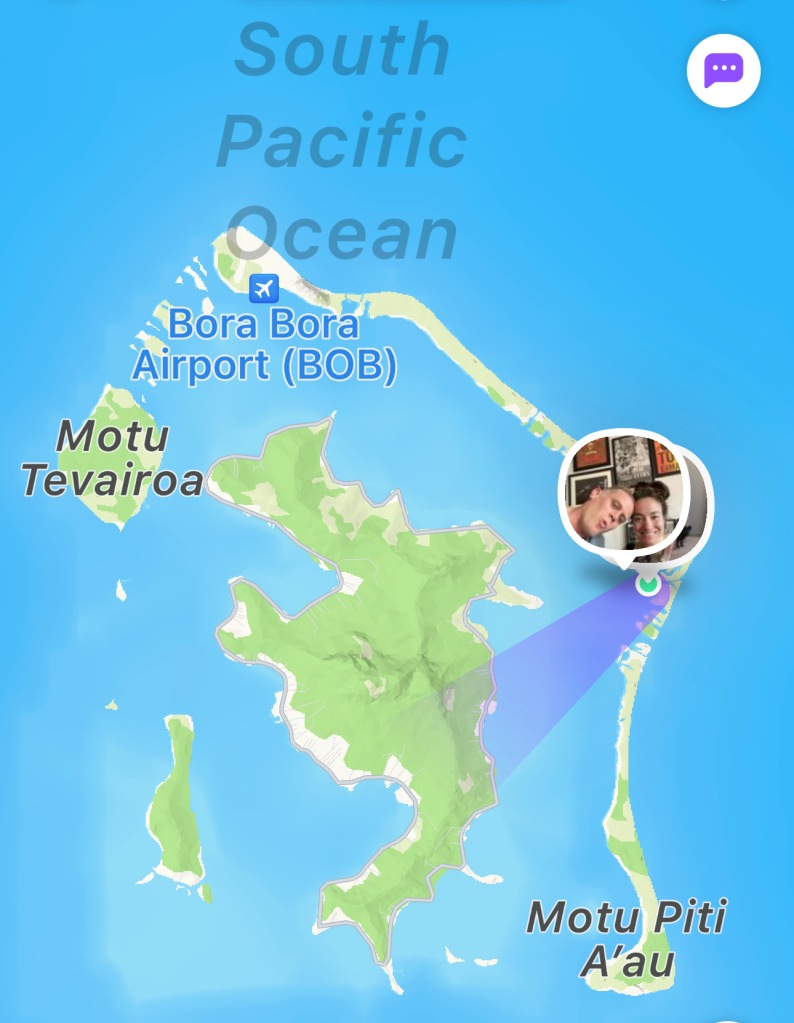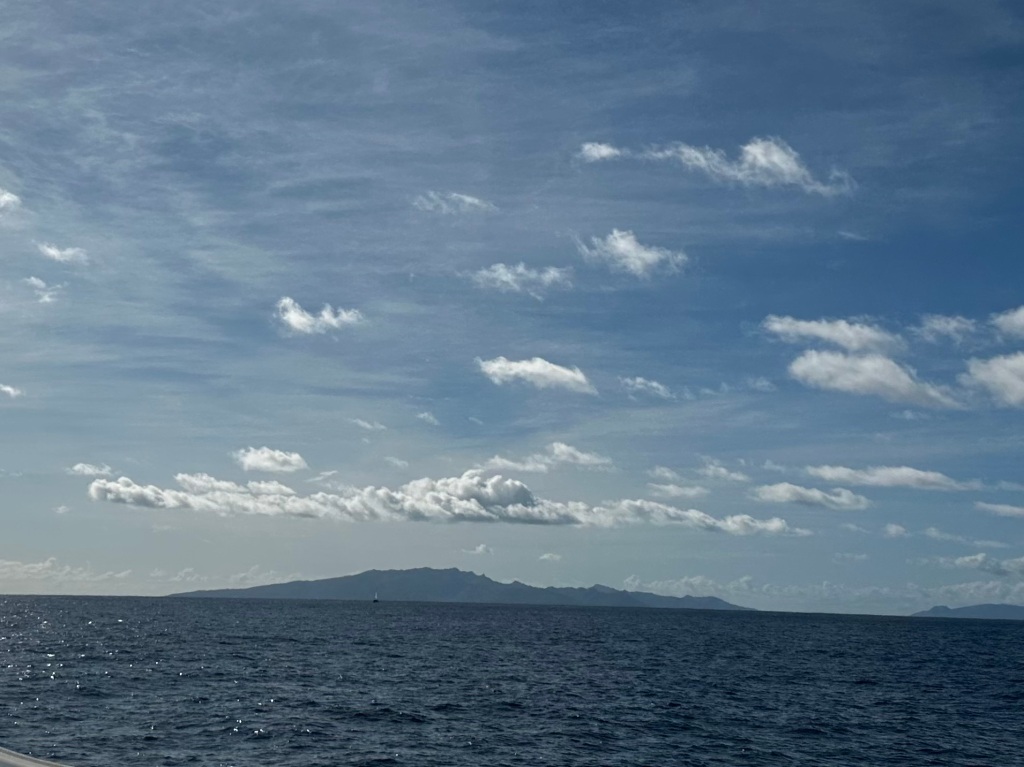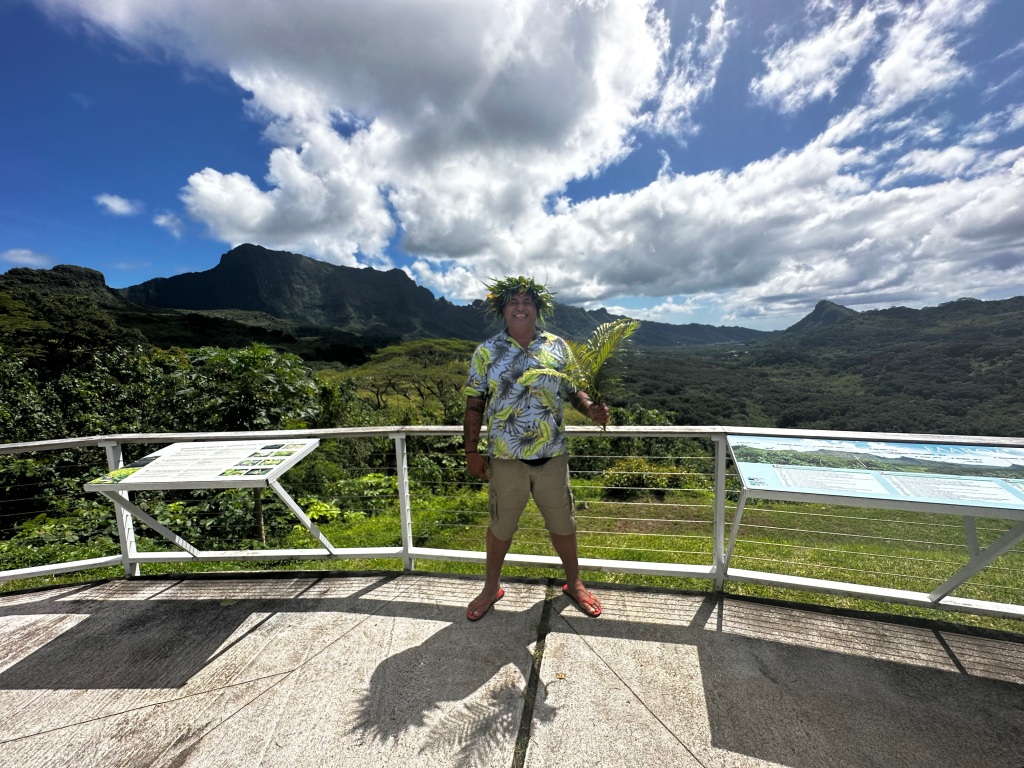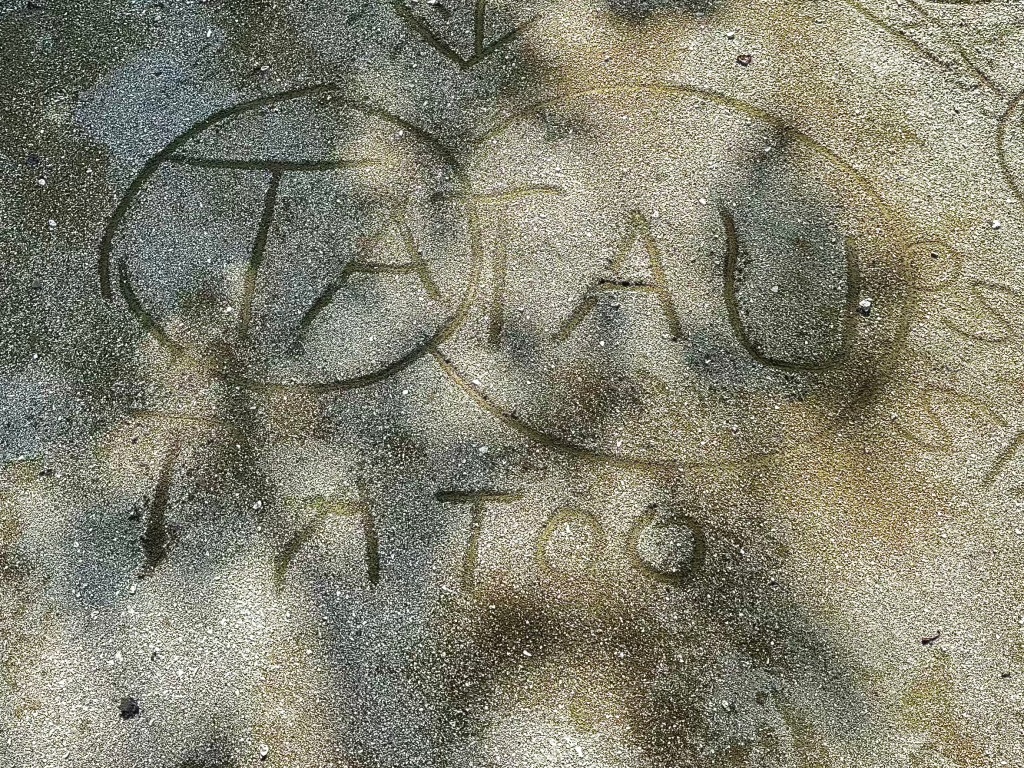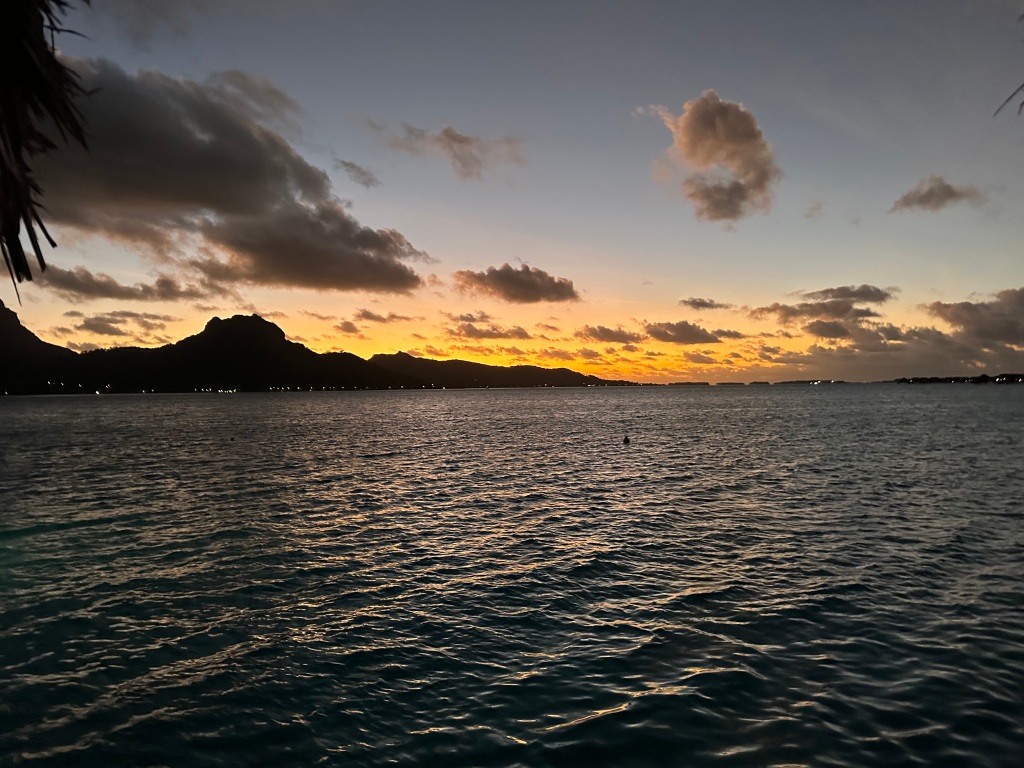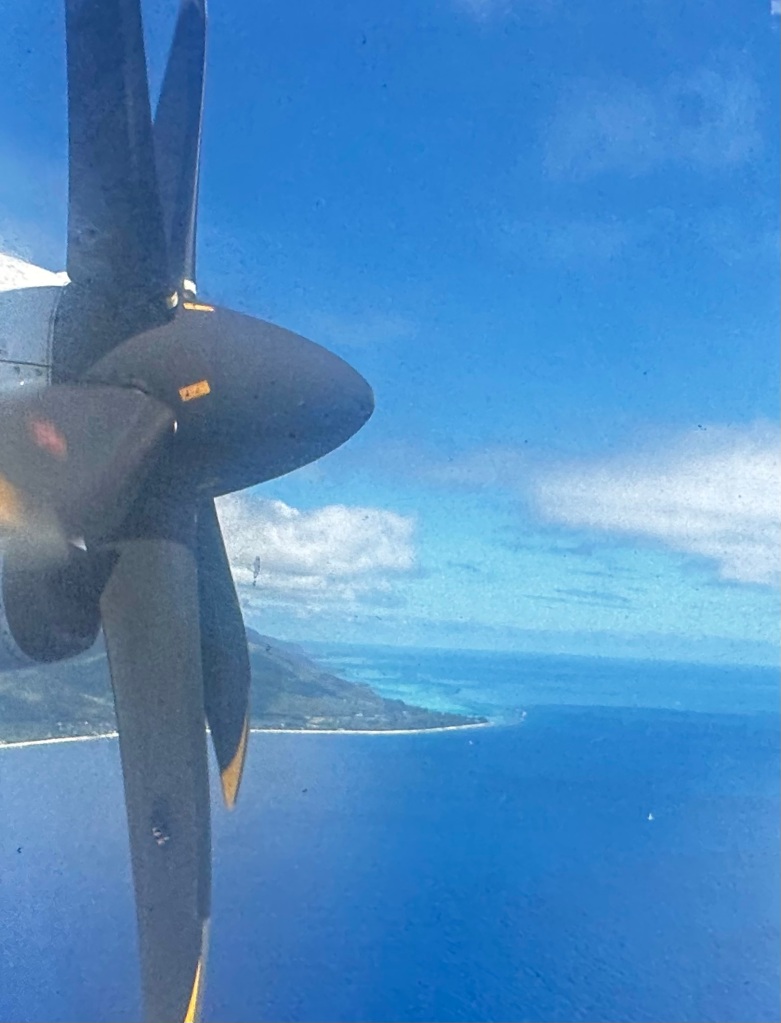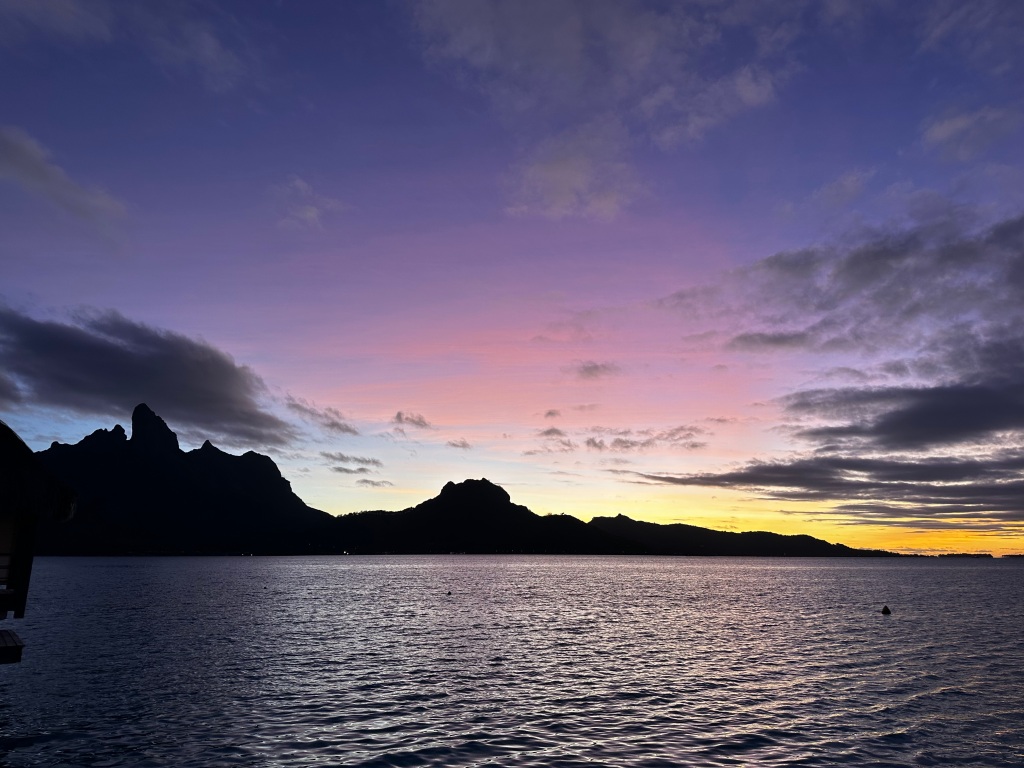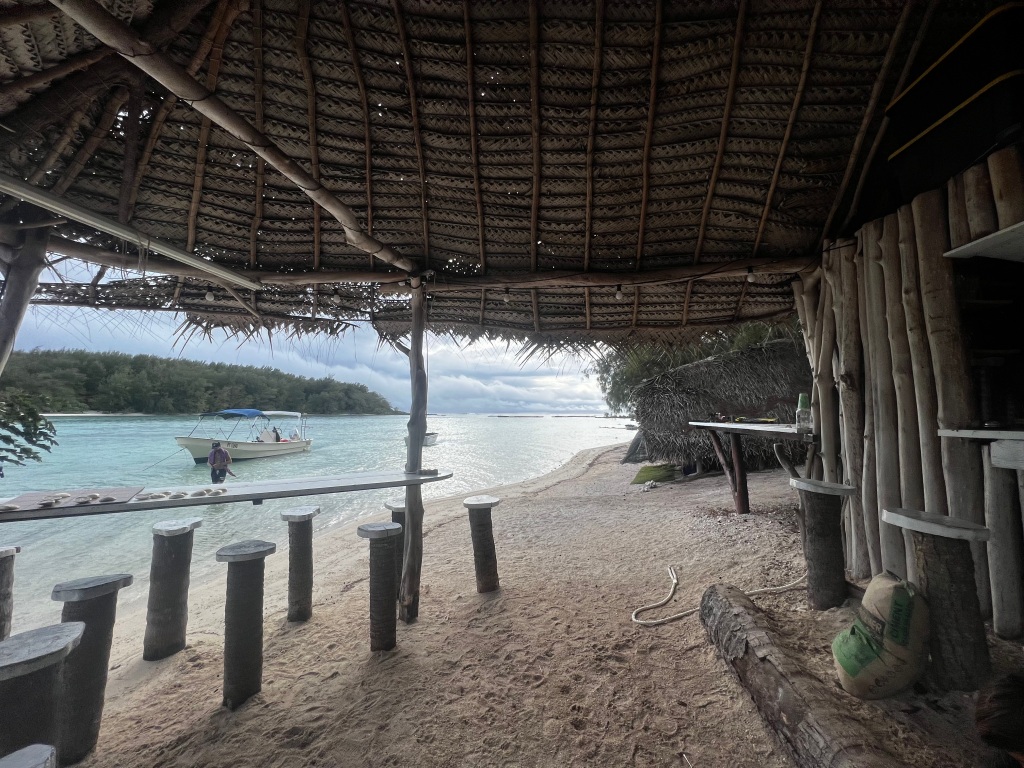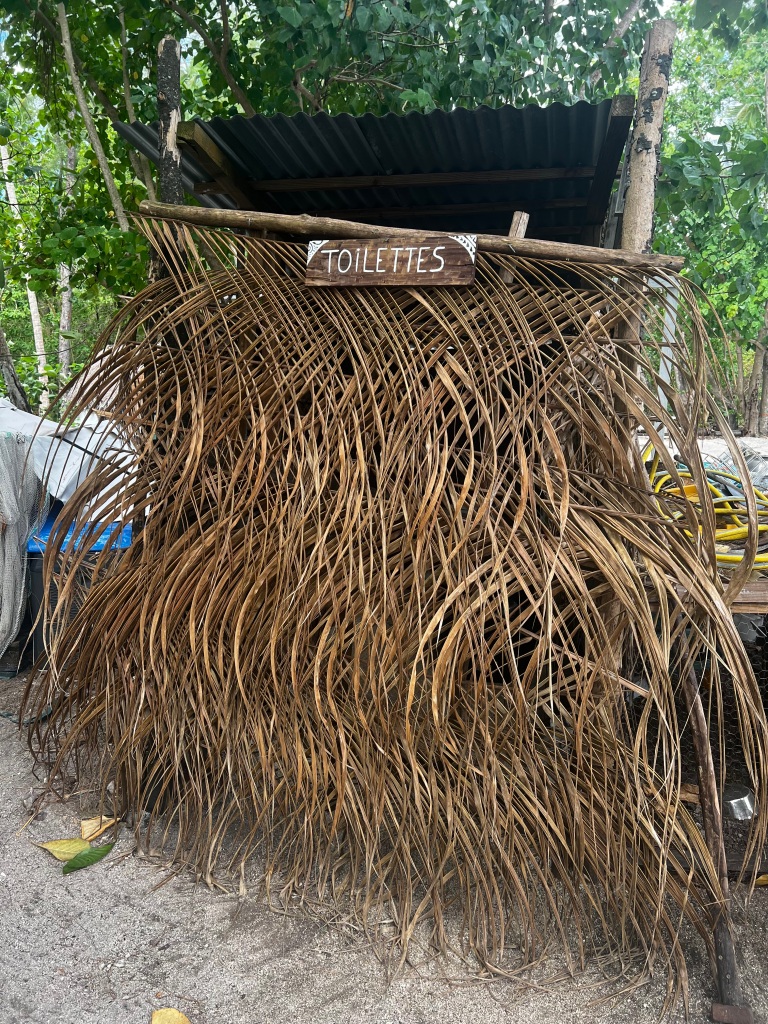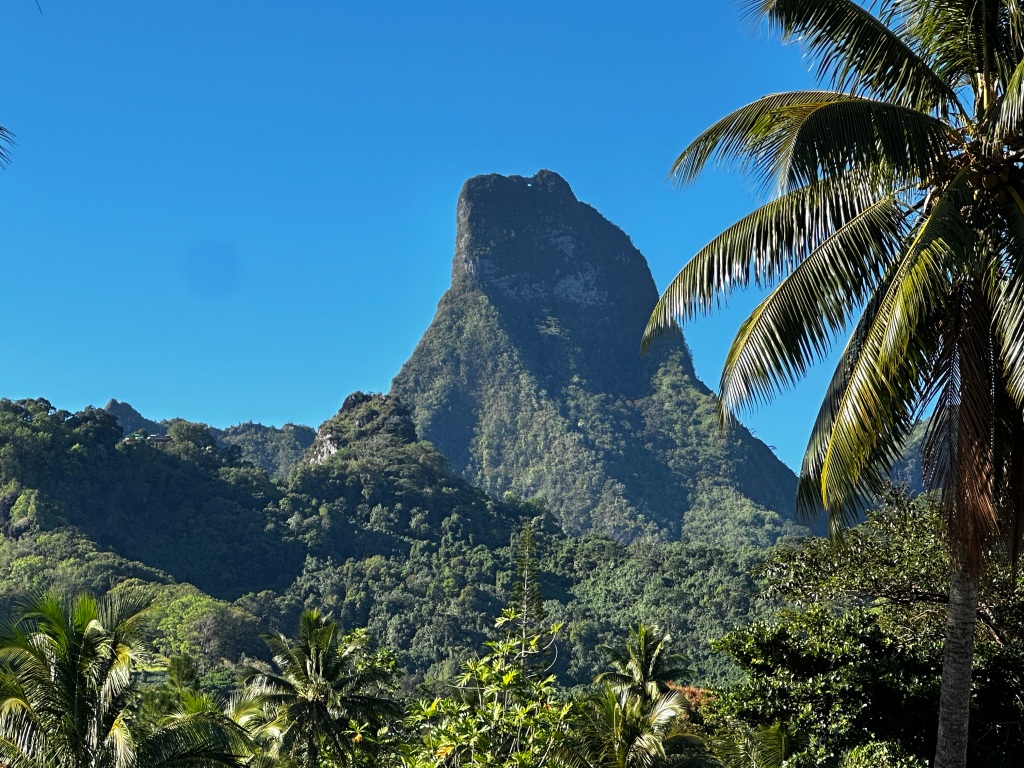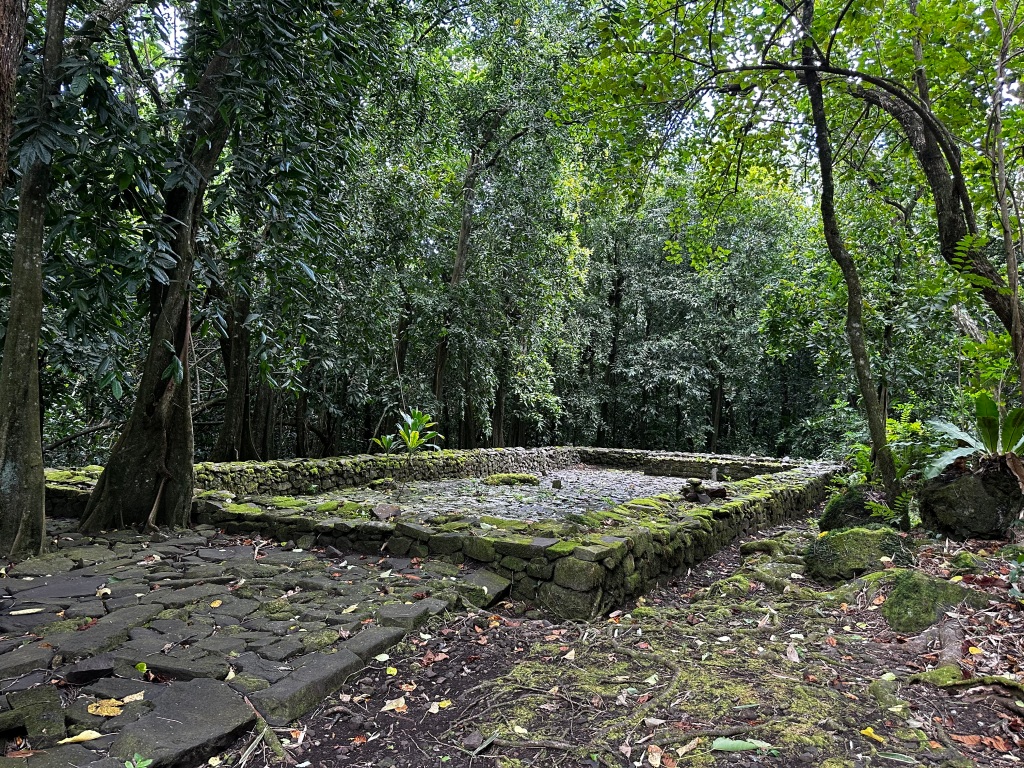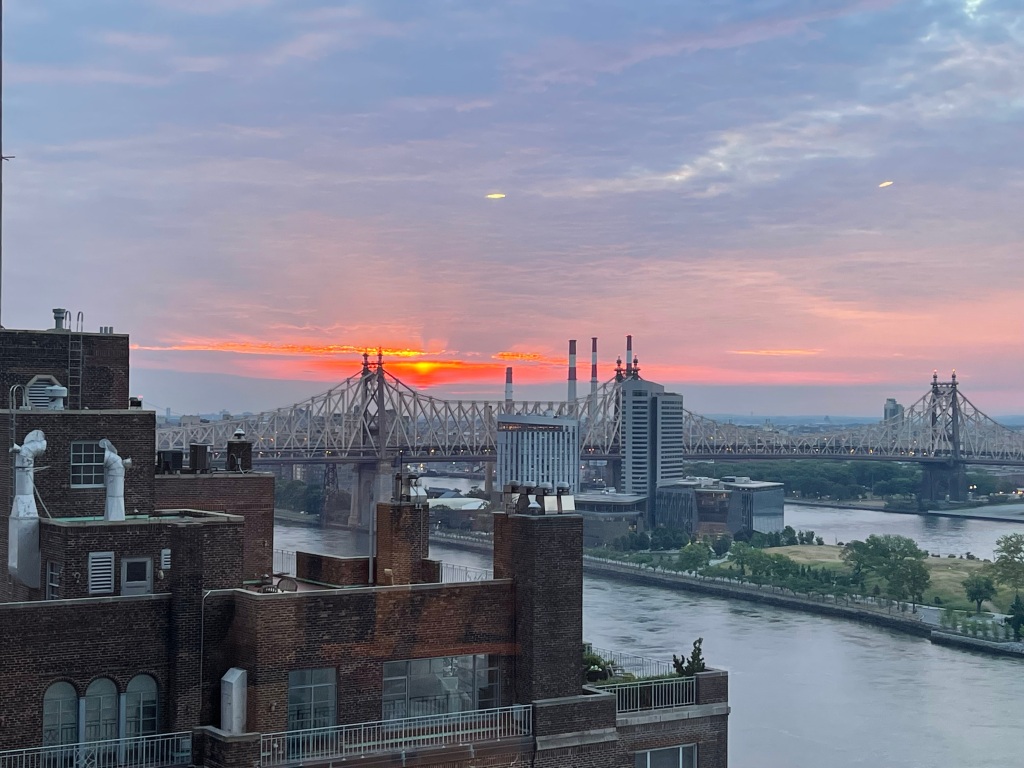
At the time that I am starting this post, we have been back home for less than 72 hours. Before I describe our last couple of days in French Polynesia, I want to thank you all for reading my words and for your kind and generous feedback. It’s been a pleasure keeping notes and writing these and quickly realizing that I have an audience – your interest buoyed me and gave a different kind of shape to this vacation than I’d expected. Keeping my creative muscles flexed is such an important part of the process, part of keeping my writer’s identity intact. I’m grateful that I had a project and that you all encouraged me to keep going.
Speaking of projects, we’ve come up with an idea for a story/animated short about a black-tipped reef shark, so if you are or know an illustrator/animator, please send me a message!
I keep forgetting to mention an important shark distinction that we learned during our travels. The reason we can snorkel and interact with the black-tipped sharks without fear is that they are scavengers, not hunters, and thus are not aggressive. Your great whites and tiger sharks, on the other hand, are hunters. Snorkeling with them is a very different experience.
Last Monday we went back to the main island and town of Bora Bora under the pretense of buying a bag with which to cart home some of the many items we acquired. What I didn’t realize then was that Mr. S had an ulterior motive …
Remember those carved wooden sculptures from the Marquesas Islands? When we first saw them, the mister fell hard for the whale, a totem of the gorgeous humpback whales we snorkeled with in Mo’orea. It is a stunning piece of art but is large and quite fragile, and I suggested that we get something smaller. So we picked up this equally beautiful and much more travel-friendly ray, in honor of the sting rays we cavorted with and the manta ray over which we swam:
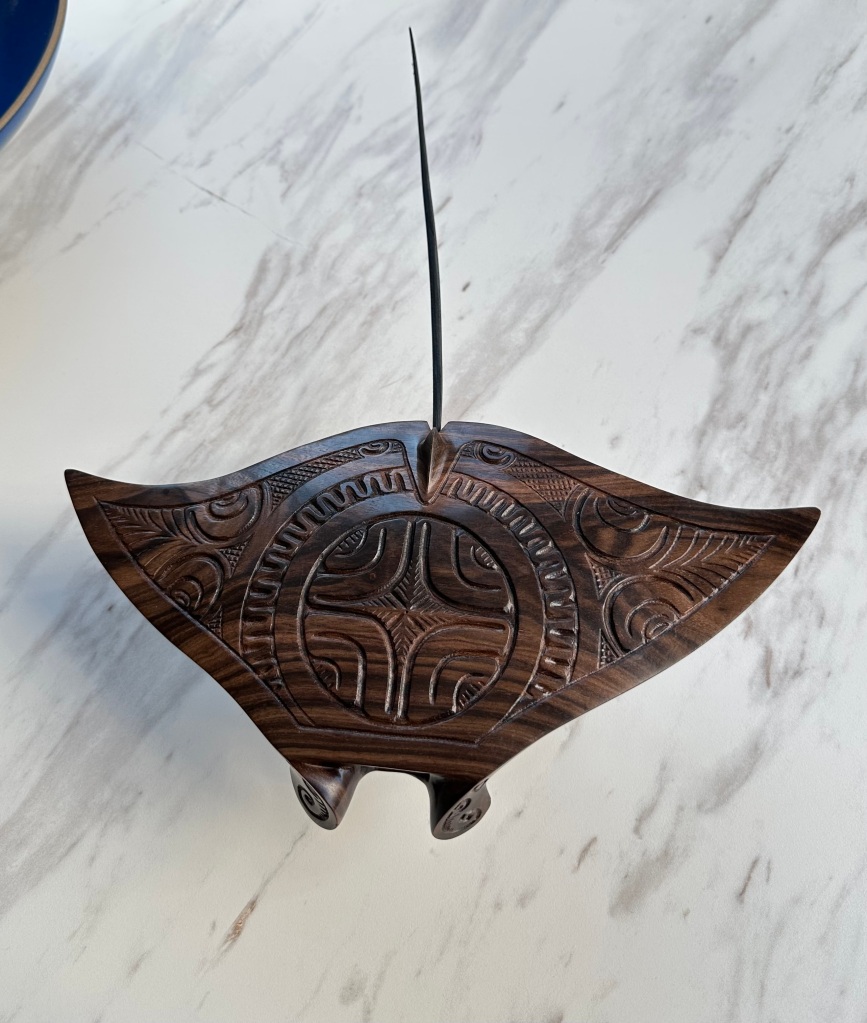
While I was back at La Galerie, the boutique we’d visited on our first trip to town, Bryan went to the grocery store to get some bottles of water. On his way to meet me, he detoured … and bought the whale. They were packing it up and so we’d return to get it before taking the boat back to the resort.
I didn’t say anything about this until now because I was SO nervous about getting it home in one piece. In fact, when we went to pick it up, the gallery owner said, “In the decades I’ve been buying art and sculpture from across these islands, I have never sold anything as fragile as this. Please be extremely careful getting it home.”
I, in turn, have never flown with something this fragile – much less on three different flights over so many hours – and it felt like traveling with a live animal—a super breakable one. We wanted to buy a seat for it but we refrained.

We were SO protective of it – had to be – and when we finally got it home, and it was in one piece, I was able to deeply appreciate its beauty.
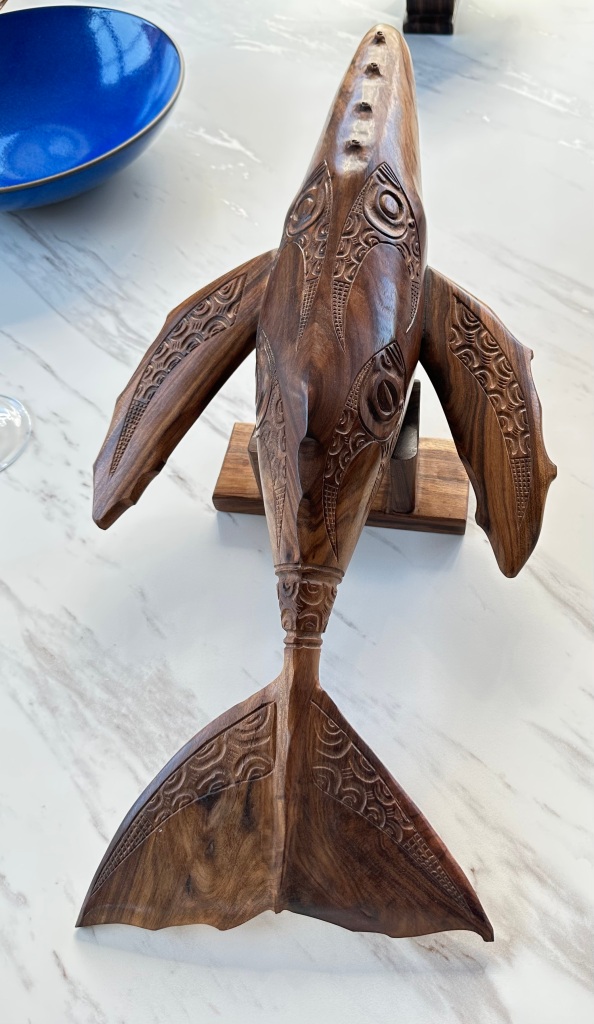

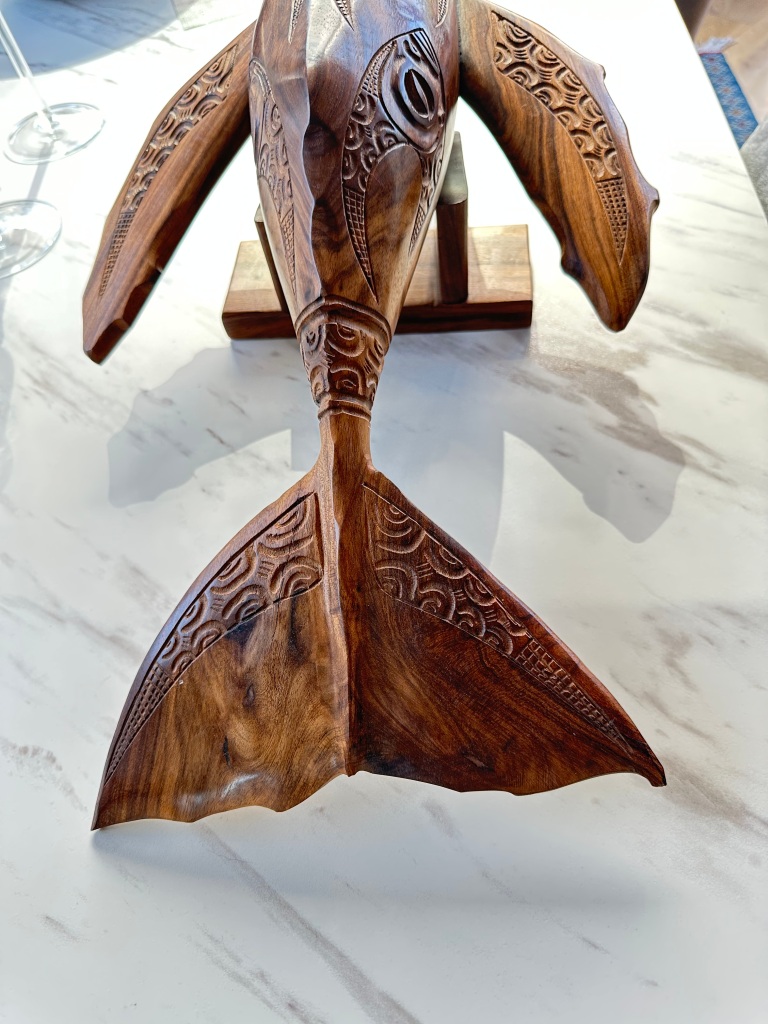
The gallery owner was happy to hear that it would be living in New York City, a place he said it is his dream to visit one day, and so we sent him this photo:

But, before we would make our triumphant return to NYC, whale in tow, we had a few adventures left in Bora Bora.
At the store where we bought the bag we also bought a couple of gifts, including a chapeau for my mom. When I was showing it to B I said, “What do you think? For Maggie?” and the shop owner said, “Mag-GIE! I love this name1”
While she was ringing us up, she said, “Deux t-shirts, un sac, le chapeau pour Mag-GIE!” and again said, “I hope Mag-GIE loves her hat!”
We flagged down a taxi to drive us back to the boat, and once we were on our way, the driver took a phone call from his wife, who needed a ride. So he pulled to the side of the road and she joined us. They talked and laughed and held hands the entire time.

Because we were not taking the regularly scheduled guest shuttle, we rode from Bora Bora to the resort on the staff commuter boat.

At lunch we chatted with Hereiti, whom we worked with throughout most of our stay on planning excursions, dinner reservations, and so on. Hereiti means “Little love” and is, she told us, a common name in French Polynesia. Our Hereiti comes from Bora Bora and still lives here, though her husband, who is from France, is currently working in Singapore as a chef. In October she will go spend the month with him. She explained that in their line of work, when a good opportunity comes up they take it, hard as it may be to be apart from one another for so long. Their hope is that he will soon work in Bora Bora again and they can be together.

After lunch we went to the beach where Bryan was determined to master the outrigger canoe we had attempted on our first day. He went out by himself while I stayed on shore with the small cheering squad that had amassed—one couple from Long Beach, California, another from the upper west side (who were also on their honeymoon, and who we’d noticed that morning as they canoed past our bungalow in Grateful Dead t-shirts … they’d attended some of the same Dead & Company shows that we did over the summer), and a couple of the guys who work there. To us, Bryan did very well—he says he still wound up tracing figure eights on the water’s surface, but all we saw was his progress.
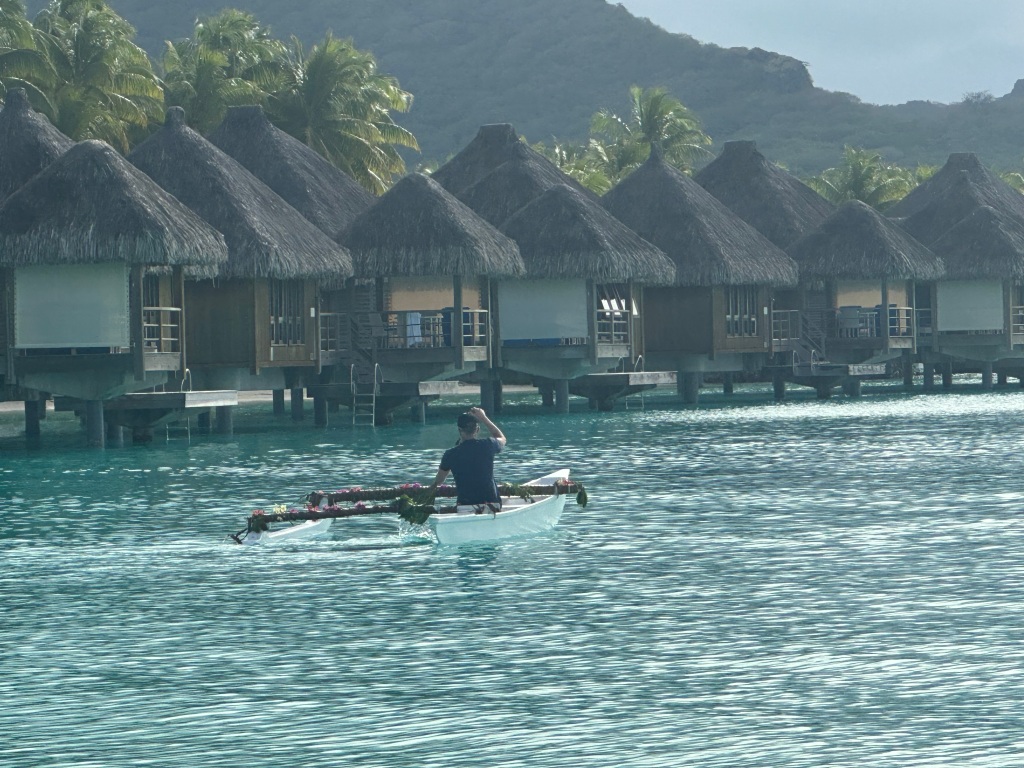
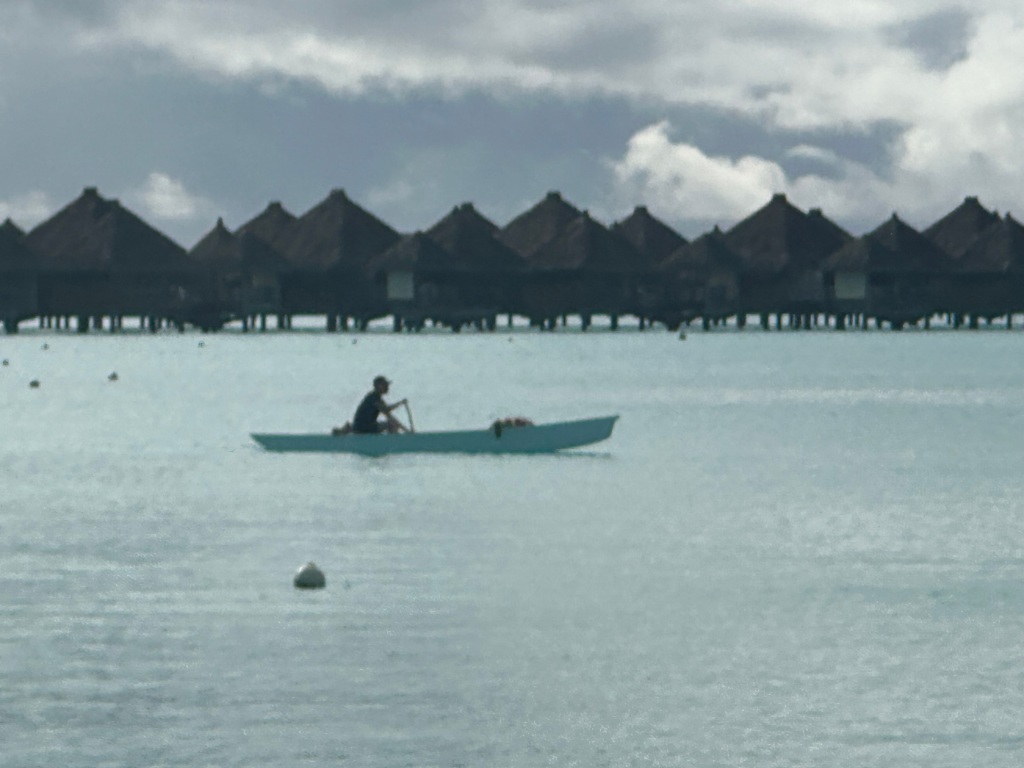

After he paddle boarded, while I made more conversation with the newlywed Deadheads, we went back to the lagoonarium for a final swim. As I mentioned in the post before this one, this was a truly incomparable experience. It had stopped raining and the fish were out in force.

As soon as we got into the water, we found Moana, the napoleon fish, and we decided to follow him. He led us on a tour of the lagoon, in yet another adventure that defies words. We swam with him for about thirty minutes, from one end of the lagoon to the other, then back again where, about halfway through, he pulled over to the side and appeared to be taking a rest. We continued on, stopping now and then to see if he would find us, but he stayed where he was.
This is what the napoleon fish, AKA the humphead wrasse, looks like (photo from Wikipedia).

The males, which Moana is, can reach up to two meters and 180 kg. This is a lot of fish, and as you can kind of see in this photo, his eyeball moves around so that as we swam together, he seemed to be constantly aware of us. I was concerned that we were making him nervous, but he is apparently very comfortable with all of the attention that he receives.
It was one of several perfect, natural sendoffs we got before leaving French Polynesia.
We had a lovely dinner that night at the resort’s Asian restaurant.

The next day it poured rain. At breakfast, Hereiti told us that the island was crying because we were leaving. We told everyone we saw that we are planning to return next summer, and we are … of course plans can change but the only way, really, that we could leave the paradise that was this vacation is by pledging to return.
We went back to our room to pack, and decided to release our gifts from Joe (the tour guide from Raiatea who stopped frequently at the side of the road to demonstrate how Polynesians create objects from the coconut palms and other leaves on the islands) into the water. We said thank you and good bye and dropped in the plate and fan that he’d made us and the crowns that we’d worn that day.

About twenty minutes later, Bryan noticed that our crowns had stayed together – the other objects had drifted, but our crowns traveled across the water together for as long as we could see them.
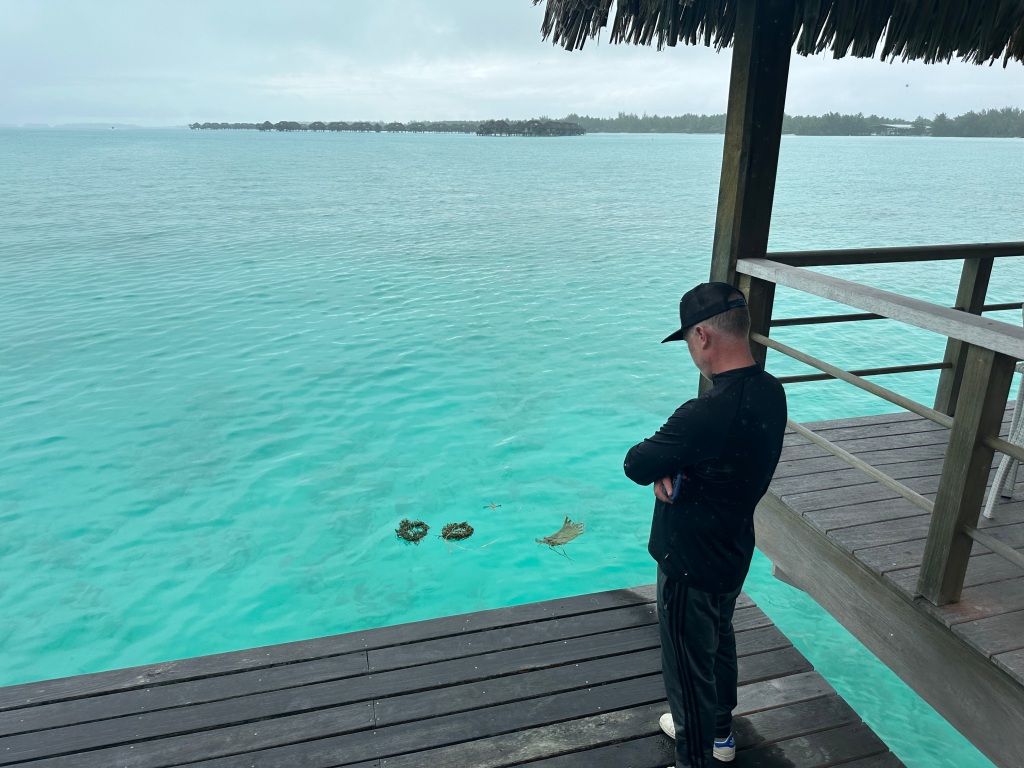

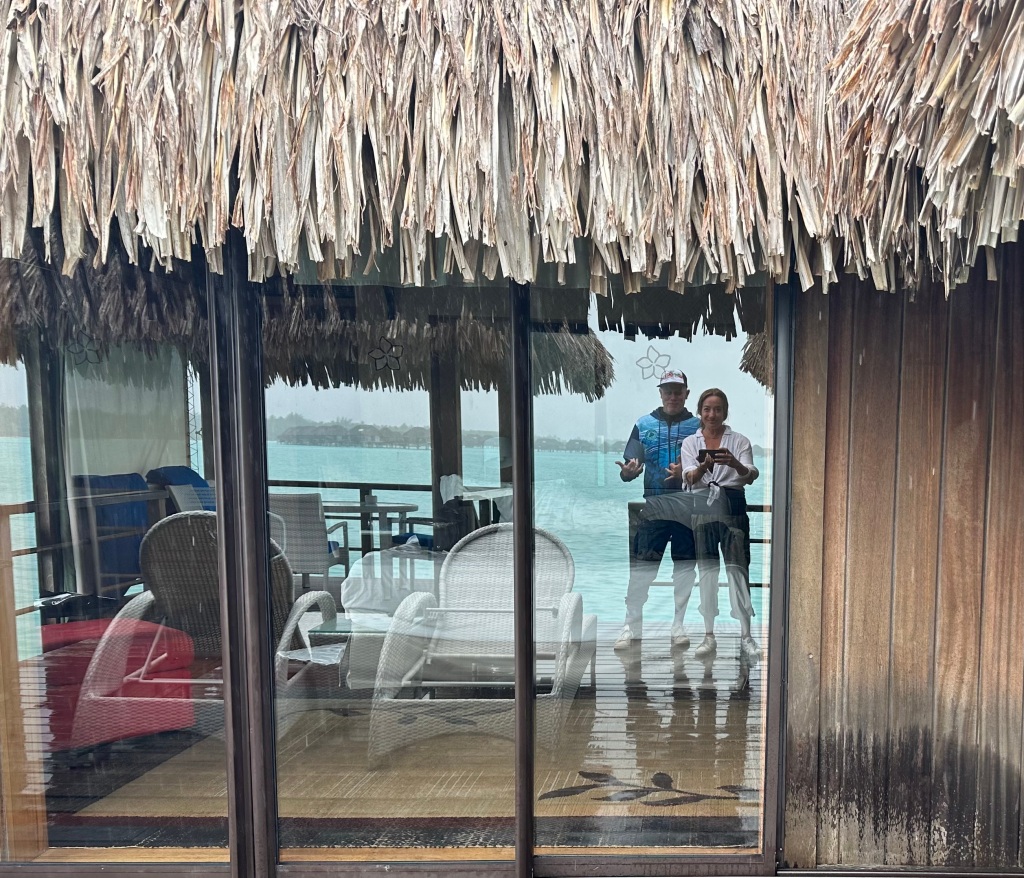
When it was time to go, a golf cart came to take us and our luggage to the boat that would take us to the airport. We were in bungalow 231, and as we pulled away, the driver called, “Bye, 231!” so we did too. As we were driving, we passed by several of the staff members, all of whom called good bye and waved—we got emotional, and again pledged our return. Hereiti came to the dock to say goodbye,

And then our boat arrived.

On checking out, you’re gifted necklaces of shells, which we wore on the first part of our trip home. Now they sit on the same display as our Marquesan wood sculptures.

If you’re a particularly nervous flyer, I would not recommend flying from Bora Bora to Tahiti during a rainstorm. As with so many of the experiences on this trip, I took comfort in the fact that the people in charge of this one know what they’re doing and do so often. The view on the way back was not quite as clear as the one we flew in to, but it was equally magical. As we approached the Tahiti airport, we could see the resort we’d stayed in on the first two nights of our trip.
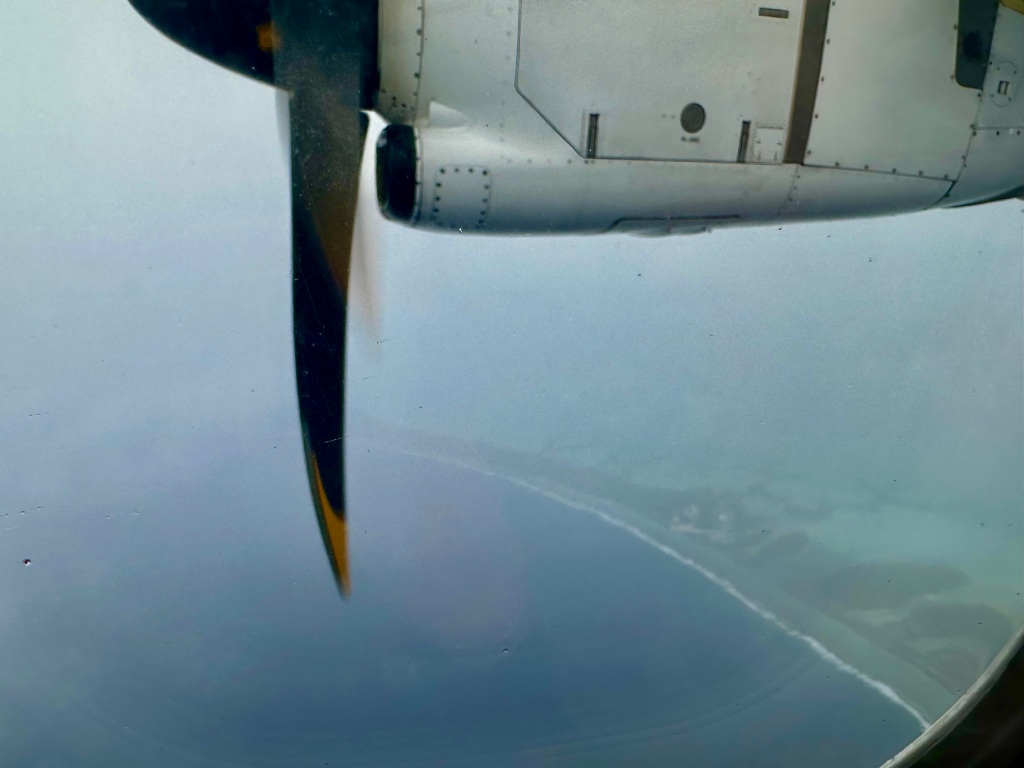


And despite the length, the flight home was perfectly manageable.

The lyric above is from “Once in a Lifetime” by the Talking Heads, which we listened to on Thursday in the car on the way to pick up Pago.
Without a doubt this was a once-in-a-lifetime experience, and even if we do return (we will) and we again snorkel with whales and sharks and rays and meet wonderful people and eat traditional lunch on a private motu and hike in the jungle and visit sacred ancestral lands and all the rest, this was our first visit to French Polynesia and it was our honeymoon. And it was perfect, mosquitoes, stomach bug, jet lag, forgotten cocktails, rainstorms and all.
Māuruuru, merci, thank you, to the beautiful people we met and the adventures we had.
Onward.
